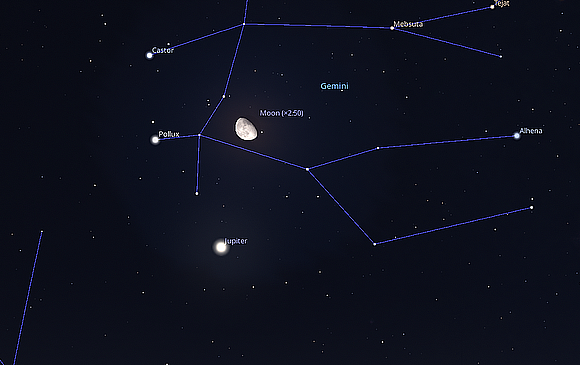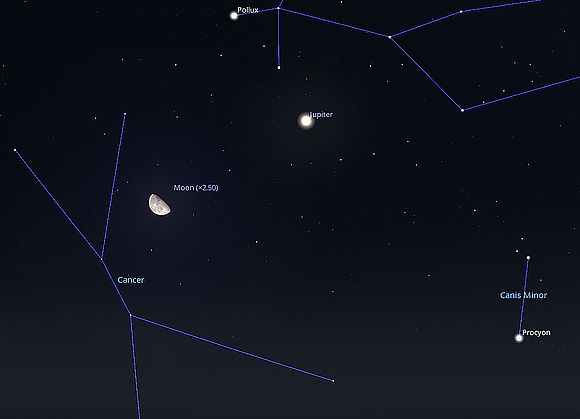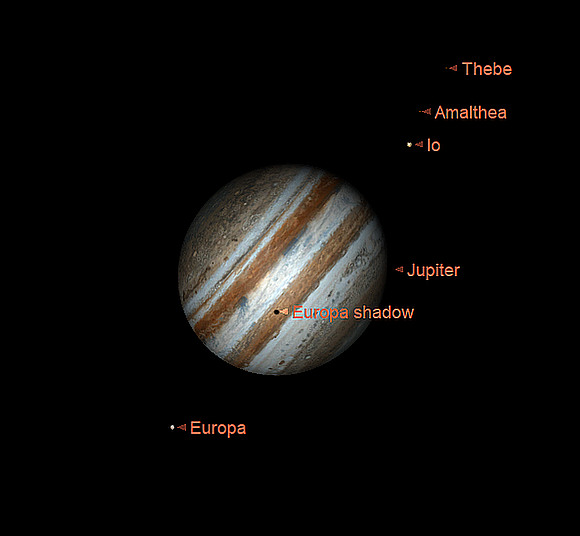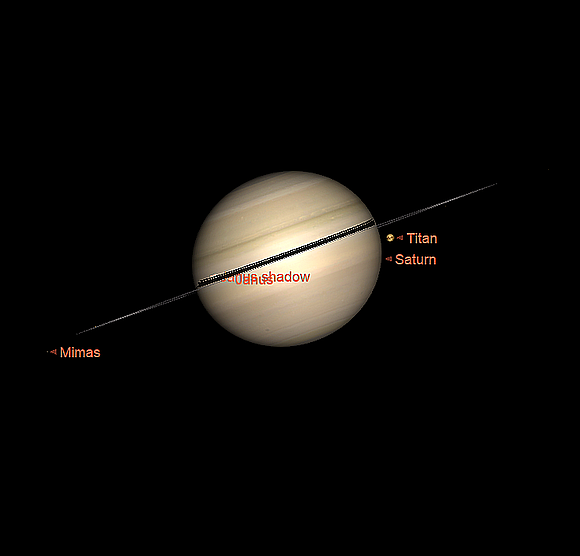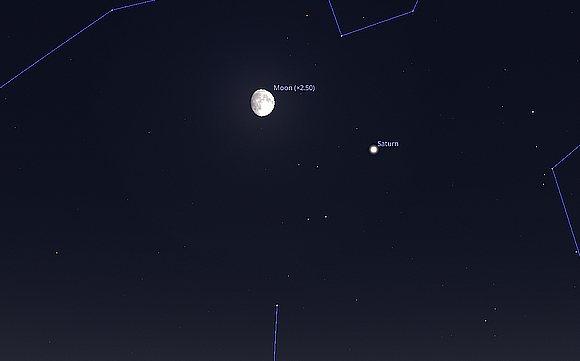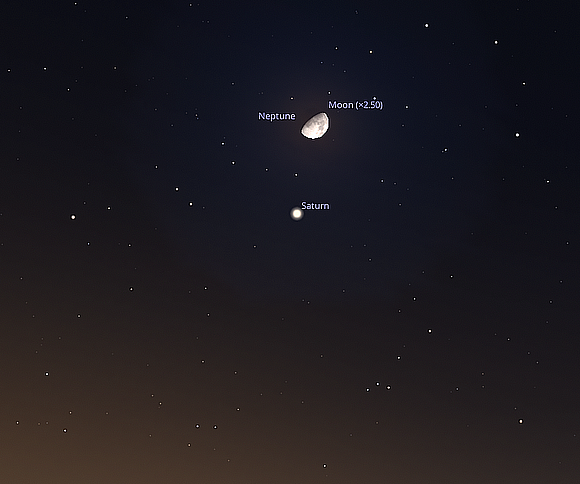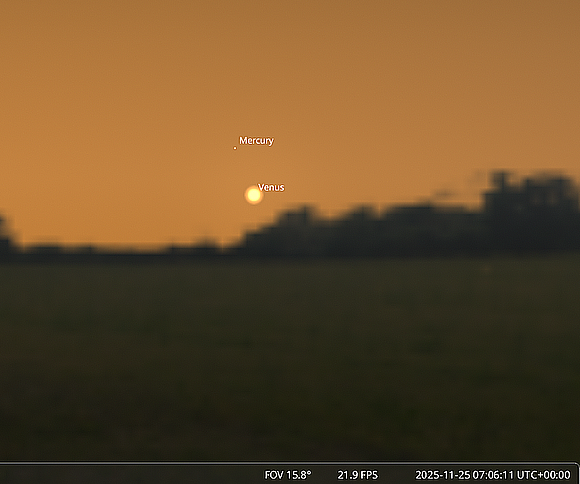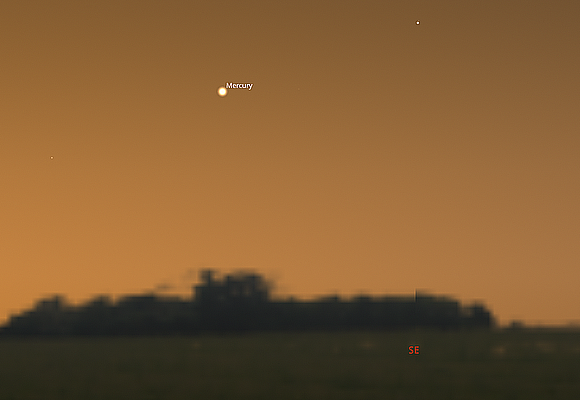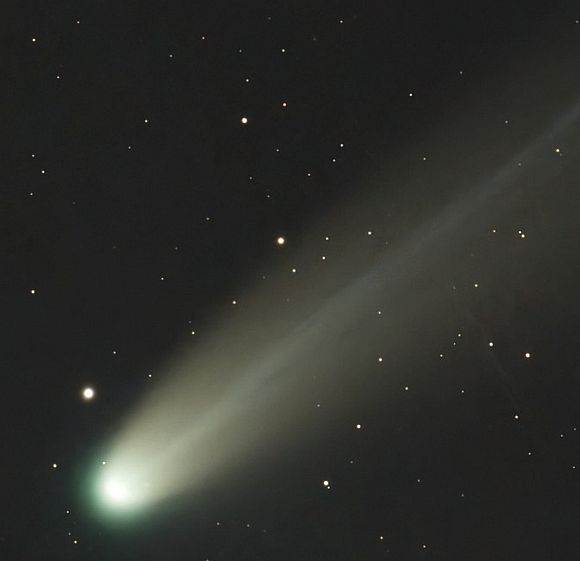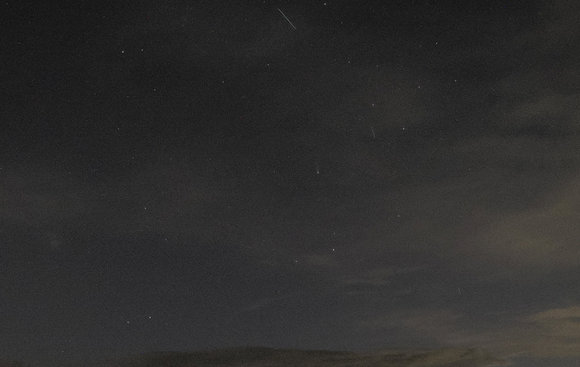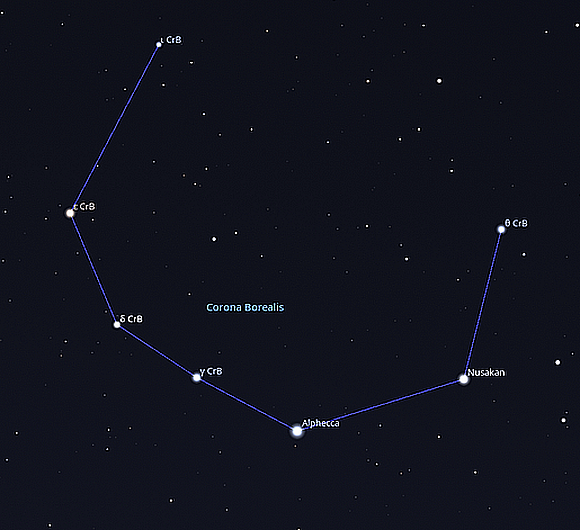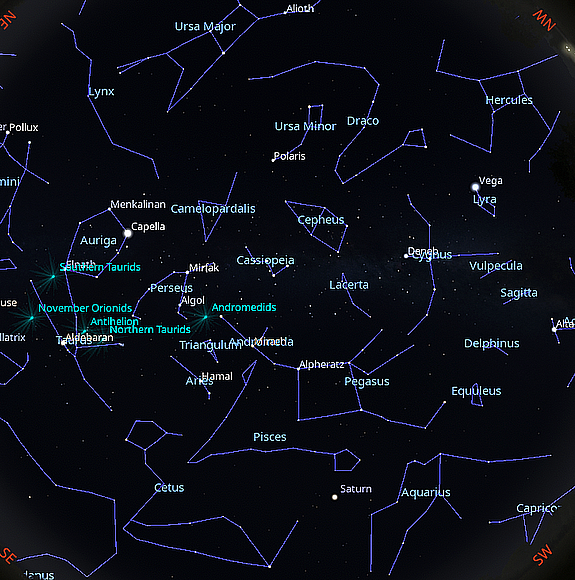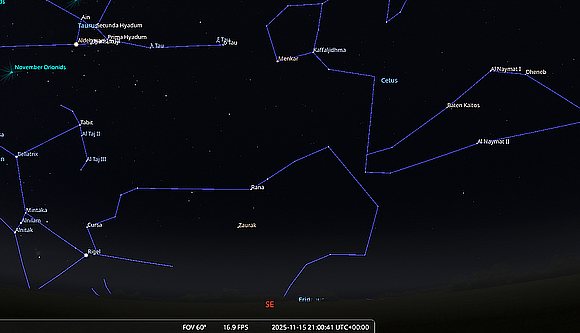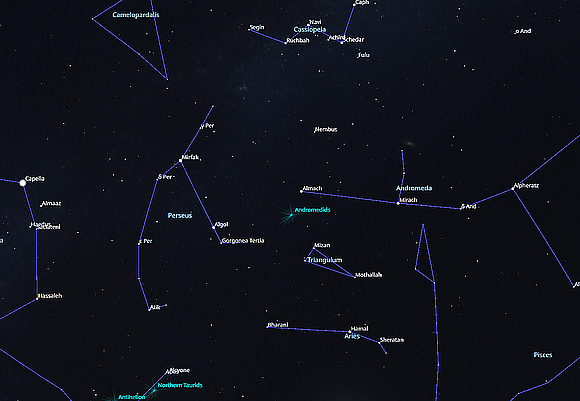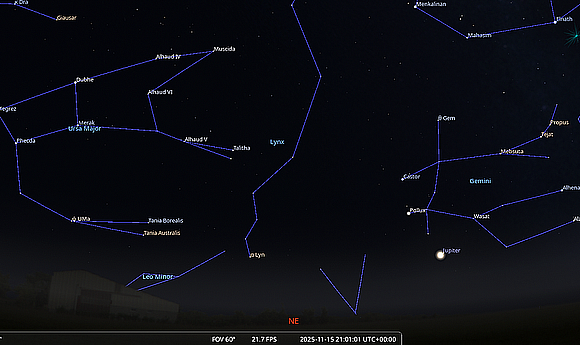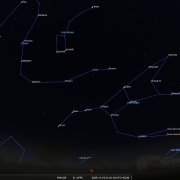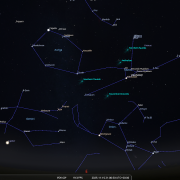In this month's Sky Notes:
- Planetary Skylights
- November Meteors, Comet A6 Lemmon
- T Corona Borealis
- November Night Sky
- November 2025 Sky Charts
Planetary Skylights: A Brief Guide to November's Night Sky
Saturn is ideally placed for observation in the night sky, but conspicuous Jupiter steals the show as it heads toward opposition in early January. Uranus comes to opposition below the Pleiades. Neptune is visible as a telescopic object 4 degrees NW of Saturn. Venus drops down to the SE horizon encountering Mercury coming the other way at the month's end.
 Jupiter becomes increasingly prominent this month, dominating the late evening sky by the end of November. Although opposition will not occur until early January 2026, Jupiter rises in the east shortly after 21:00hrs GMT at the beginning of November, shifting to approximately 19:15hrs by month's end. The planet is positioned just below the main outline of Gemini. After remaining nearly stationary against the stellar background, Jupiter gradually begins its retrograde motion westward throughout November. By the end of the month, Jupiter attains a magnitude of -2.53.
Jupiter becomes increasingly prominent this month, dominating the late evening sky by the end of November. Although opposition will not occur until early January 2026, Jupiter rises in the east shortly after 21:00hrs GMT at the beginning of November, shifting to approximately 19:15hrs by month's end. The planet is positioned just below the main outline of Gemini. After remaining nearly stationary against the stellar background, Jupiter gradually begins its retrograde motion westward throughout November. By the end of the month, Jupiter attains a magnitude of -2.53.
A waning gibbous Moon lies nearby Jupiter in the sky on November 9th & 10th.
Viewed through a telescope, Jupiter's flattened globe spans a generous 42 arc-seconds, making it a delightful target even for relatively small instruments. The darker cloud bands near the equator are easy to spot, and you’ll also notice the lighter polar regions. With apertures over 200mm (8"), you may catch sight of the subtler temperate belts in the north and south.
The famous Great Red Spot—Jupiter’s major storm—should be visible with telescopes as small as 100mm (4”), though it stands out more when using a 150mm (6”) scope at medium magnification. It is a fact however, to note that the Great Red Spot appears less vivid and smaller than it did three decades ago. For the best views of the GRS, observe on the 4th, 6th, 11th, 16th, 18th, 23rd, 28th, and 30th between 21:00hrs and 22:00hrs GMT.
One aspect of the Jovian system immediately evident are the attendant Galilean moons, visible as specks of light. The dance of these four large satellites over successive nights is fascinating to follow. Watch out for Galilean moon shadow transits, visible on the disk of Jupiter as dark spots. Use apertures above 100mm (4") for this. The more favourable evening events this month being Europa - Nov 15th around 22:15hrs GMT, Ganymede Nov 17th @ 22:45hrs GMT, and Io - Nov 22nd around 21:30hrs GMT.
 Saturn is ideally located for observation throughout the evening although by the end of November it is setting before 01:00hrs. At magnitude +0.8, Saturn appears conspicuous against the fainter aquatic stellar backdrop of the Pisces/Aquarius border - a region devoid of brighter stars. Saturn culminates a respectable 33 degrees above the horizon - a few degrees shy of the celestial equator, which it finally crosses in 2026, but high enough to clear the worst of unsteady 'seeing'.
Saturn is ideally located for observation throughout the evening although by the end of November it is setting before 01:00hrs. At magnitude +0.8, Saturn appears conspicuous against the fainter aquatic stellar backdrop of the Pisces/Aquarius border - a region devoid of brighter stars. Saturn culminates a respectable 33 degrees above the horizon - a few degrees shy of the celestial equator, which it finally crosses in 2026, but high enough to clear the worst of unsteady 'seeing'.
Saturn's rings almost edge-on with occultation of Titan - Nov 14th @ 18:40hrs GMT.
(Click for larger image)
Saturn is usually a spectacular sight through the eyepiece, but since this is a ring plane crossing year, the rings have appeared very shallow for most of the year and will be open less than half a degree during November. However, this makes it easier to spot some of Saturn’s moons that are normally harder to see. Dione, Rhea, and Tethys should all be visible with modest-sized telescopes. Titan—by far Saturn’s largest moon—is typically seen as a nearby point of light, but this month it will participate in several transits and occultations with Saturn. The best opportunity to view a transit occurs on November 6th between 21:30hrs and 23:00hrs GMT, while an occultation, where Titan passes behind Saturn, happens on November 14th at 18:40hrs GMT.
The Moon pays Saturn a visit on Nov 1st and 2nd and again on Nov 29th when it is also close to Neptune.
 Neptune is well placed for telescopic observation in the evening sky, the outermost planet sitting approximately 4-degrees upper left of Saturn. With a magnitude of +7.8, Neptune is observable with binoculars, although a telescope is necessary to discern its tiny blue-grey disk, which measures 2.8 arc-seconds in diameter. Instruments of 100mm (4") aperture are generally adequate for this but telescopes exceeding 150mm (6") will reveal it more clearly.
Neptune is well placed for telescopic observation in the evening sky, the outermost planet sitting approximately 4-degrees upper left of Saturn. With a magnitude of +7.8, Neptune is observable with binoculars, although a telescope is necessary to discern its tiny blue-grey disk, which measures 2.8 arc-seconds in diameter. Instruments of 100mm (4") aperture are generally adequate for this but telescopes exceeding 150mm (6") will reveal it more clearly.
On the night of November 29th, the waxing quarter Moon sits to the right of Neptune with Saturn below.
 Uranus reaches opposition this month on Nov 21st and will therefore be visible all night. The third largest planet lies in Taurus less than four degrees below the lovely Pleiades star cluster. It is located within the same binocular field as 13 & 14 Tau, which lie upper right. Visible as a faint magnitude +5.6 object, Uranus is technically a naked eye object under very dark skies but will be a tricky spot from UK shores. Through binoculars, Uranus appears as a faint point, with apertures of at least 80mm (3+ inches) required to resolve its small 3.7 arcsecond greenish disk. This becomes more distinct in instruments of 150mm (6”) or larger.
Uranus reaches opposition this month on Nov 21st and will therefore be visible all night. The third largest planet lies in Taurus less than four degrees below the lovely Pleiades star cluster. It is located within the same binocular field as 13 & 14 Tau, which lie upper right. Visible as a faint magnitude +5.6 object, Uranus is technically a naked eye object under very dark skies but will be a tricky spot from UK shores. Through binoculars, Uranus appears as a faint point, with apertures of at least 80mm (3+ inches) required to resolve its small 3.7 arcsecond greenish disk. This becomes more distinct in instruments of 150mm (6”) or larger.
 Venus is now very low in the eastern dawn sky, reaching the end of a mediocre morning apparition for mid-northern latitude observers. It is best seen around 07:00hrs at the start of the month. At magnitude -3.8, Venus will be conspicuous but not if the observers view to the east is badly compromised. Before Venus departs late in the month it has a meeting with Mercury coming the other way, although the conjunction will be challenging (See Mercury). A very slim crescent Moon resides to the right of Venus on Nov 18th - view at 07:00hrs.
Venus is now very low in the eastern dawn sky, reaching the end of a mediocre morning apparition for mid-northern latitude observers. It is best seen around 07:00hrs at the start of the month. At magnitude -3.8, Venus will be conspicuous but not if the observers view to the east is badly compromised. Before Venus departs late in the month it has a meeting with Mercury coming the other way, although the conjunction will be challenging (See Mercury). A very slim crescent Moon resides to the right of Venus on Nov 18th - view at 07:00hrs.
 Mercury pops into the dawn sky near the end of November, passing Venus in a challenging conjunction on Nov 25th when the two are just a degree apart. Both will be just a few degrees above the SE horizon - so a flat aspect to the east is essential. Timing is also critical - there will be little time in which to spot them, roughly 20 minutes starting from just after 07:00hrs. By 07:20hrs Mercury will be lost in brightening twilight. Venus will appear much brighter - but lower, with Mercury above. Use binoculars to assist as you may not spot Mercury with the naked eye, which will be quite a challenge at magnitude +1.8.
Mercury pops into the dawn sky near the end of November, passing Venus in a challenging conjunction on Nov 25th when the two are just a degree apart. Both will be just a few degrees above the SE horizon - so a flat aspect to the east is essential. Timing is also critical - there will be little time in which to spot them, roughly 20 minutes starting from just after 07:00hrs. By 07:20hrs Mercury will be lost in brightening twilight. Venus will appear much brighter - but lower, with Mercury above. Use binoculars to assist as you may not spot Mercury with the naked eye, which will be quite a challenge at magnitude +1.8.
Following this, Mercury rises higher above the horizon, reaching 9 degrees by the end of the month about 40 minutes before sunrise, and its brightness increases to +0.3. As with all morning appearances, this elusive inner planet will keep brightening before eventually descending toward the horizon again.
November Meteors

Considered the main meteor shower in November, the Leonids are active from Nov 15-20th, usually peaking over the night of the 17/18th. The shower is famous for the periodic storm outburst at intervals of roughly 33 years.
Away from 'storm peak' years, Leonid activity is very modest amounting to 10-20 per hour at best, as should be the case this year. At least moonlight will be negligible presenting the best opportunity to spot a few shooting stars in the early morning hours when the constellation of Leo (the radiant of the shower) is located high above the southern horizon.
The shower is associated with comet 55/P Temple-Tuttle, which returns to the inner solar system every 33 years, leading to 'storm rates' of 100s, 1000s and even 100,000s meteors per hour. The next 'storm' level event is predicted to be November 2031 or 2032. Leonids are some of the swiftest meteors, penetrating the upper atmosphere at speeds of 45mps or 72 km/second, often leaving bright and persistent trains in the sky. If the night of 17/18th is clear, keep one watchful eye open at least!
Also in November, keep the other eye open for a few meteors on the night of 4/5th Nov when the South Taurid meteor shower reaches a peak. A second peak follows on the night of Nov 11/12 for the North Taurid meteor shower. The hourly rate is low for both showers; only around 5 meteors, but these can be bright with occasional fireballs! The Taurids are an old shower, associated with the periodic Comet Enke. Over time dust from this comet has been depleted and spread out over a broad swath of the inner solar system, giving rise to Taurid meteor showers not only on Earth, but also on Mars and Venus too!
Comet A6 Lemmon
Annoyingly, the appearance of Comet A6 Lemmon low in west sky came just after October's notes were published, my fault, should have highlighted it anyway - we know how unpredictable comets can be. Predicted to reach magnitude +7 to +8, revised down from +10, Comet Lemmon was as of writing (Oct 29th) just visible to the naked eye, around mag +4.3.
The comet was discovered in January 2025 by the Mt Lemmon observatory in Tucson - USA. Initially a 'dot', the comet has brightened considerably, far more than astronomers expected and may reach magnitude +3.4 by early November. Unfortunately, the comet has been heading down from Canes Venatici, through Serpens and into Ophiuchus (November) and will then be lost to UK observers.
A6 Lemmon has an orbital period of around 1150 years, revised down from 1350 years following this passage - so it may have potentially been seen last by sky watchers in the Middle Ages! Several images have been captured by WDAS members of comet Lemmon low in the west sky towards the end of October. The comet was easily seen in binoculars, but difficult with the naked eye. Tracked images really showed the comet's tail in some detail, but now sadly hidden from our vantage point.
This is how A6 Lemmon approximately looked to the naked eye from a rural site.
Can you spot it? Image - Mark D. (Click for full image)
T Corona Borealis.
We are still awaiting the eruption of the recurrent nova star T Corona Borealis, mid-November being a period when all observers should be very much 'on their guard'. T Cor B erupts approximately every 80 years, with the last outburst recorded in 1946. Normally at magnitude +10, which is near the limit of typical binoculars, during the two well-documented outbursts observed, it reached mag +2.0 in 1866 and mag +3.0 in 1946.

Artist impression of T Cor B system.
T Cr B is a binary system containing a large cool M3 class component, perhaps a 190 million km (120 million miles) in diameter and a smaller, hotter, more massive component - a white dwarf approximately 6400 km (4000 miles) in diameter. The system is surrounded by an accretion disc of material being pulled from the red giant. The two components of the system orbit each other every 227.5 days and lie almost 3000 light years away. Of the recurrent nova known T Cr B is by far the brightest example.
T Coronae Borealis doesn't explode as a supernova because its white dwarf star is not massive enough, and the process involves a recurrent nova cycle where only the accreted hydrogen on the surface detonates, leaving the white dwarf intact. In contrast, a Type 1a supernova requires the white dwarf to reach a critical mass of about 1.44 solar masses, which would then cause the entire white dwarf to be destroyed.
Initial predictions suggested the nova would occur in 2024, but it did not happen. Based on recent observations, astronomers have speculated the outburst could occur at the end of the 228-day orbital period, the next one being around Nov. 10th, 2025. Failing this, T Cor B completes additional orbits on June 25th, 2026, and Feb. 8th, 2027. Whenever it does finally happen it will be headlining news, and we'll be alerted within 24 hours. Given that T Cor B will only be a naked eye object for perhaps a week, this should entail everyone can view this once in a lifetime (for most) event. It's just a wating game now!
November Night Sky
November is not the month it used to be weatherwise. Save a heatwave, it is a month for any kind of weather, although it is becoming milder. A month when trees shed the last of their colourful leafy autumn coats - abruptly, or at their leisure, leaving winter poised on the threshold by the month's end. Twilight deepens late afternoon, frost bitten only occasionally, the impact of climate change written across our shores more often these days. Post 2011, November is now a month masquerading as October.
Above our heads the constantly changing celestial tapestry lies never still, but even on the cusp of winter sections of the sky still reflect seasons long departed. Here the stars of the summer triangle; Vega, Deneb, Altair, and associated constellations, remain conspicuous as darkness falls, still accessible for observation.
Deneb shines atop Cygnus - the Northern Cross, starting to resemble more the outline of a crucifix as it descends towards the WNW horizon. High in the NW, brilliant steely-blue Vega illuminates the lozenge outline of Lyra, both it and Deneb circumpolar from our latitude remaining visible throughout winter, dipping close to the north horizon. Only Altair in Aquila the Eagle will migrate, vacating the sky during late evening after mid-month, seeking quarry in warmer climes.
Facing north the familiar Plough asterism in the constellation of Ursa Major has now reached its lowest station on its endless journey about the celestial pole - conveniently marked (almost) by Polaris - the Pole star. Utilise the pointer stars; Dubhe and Merak in the 'bowl' of the Plough to track down Polaris sitting at the tip of Ursa Minor’s tail. Between these two celestial bears wind the faint stars of Draco, the head of the dragon marked by an irregular quadrilateral of fainter stars to the right of Vega in the WNW.
Use the 'arc' of the Plough's handle to locate the brilliant star Arcturus setting in the NW in the spring constellation of Boötes, its journey below the horizon short, rising again in the ENE by 03:00hrs GMT from mid-UK latitudes.
Departing with Boötes, Corona Borealis (See - T Cor B) and the upper body of Hercules (technically lower body as Hercules is depicted as being upside down on stellar charts). Again, their absence is temporary, visible in the NE by dawn. Due South, arranged below the great square of Pegasus reside the constellations of Pisces and Aquarius, neither group blessed with conspicuous stars. Saturn currently resides on the border of these two constellations. The large constellation of Cetus the whale resides below Pisces, use the front two stars in the square to locate its brightest star Diphda.
The most famed object in Cetus is the variable star omicron ceti - otherwise known as Mira the wonderful, an extraordinary pulsating red super giant - perhaps 300 million miles in diameter. When at maximum, a period lasting some 10 days, Mira is easily visible to the naked eye and can rival Menkar. Mira’s slow decline to minimum takes seven months by which time binoculars struggle to pick out the +10.2 star! The whole period takes 332 days, the next maximum being March/April 2026. Mira lies roughly midway between Menkar and Diphda.
High to the South, stretching eastwards away from Pegasus, the stars of Andromeda sweep up toward the heroic figure of Perseus climbing high into the ENE. The constellation of Perseus itself lies partly within the rich Milky Way and is well worth exploring with augmented eyes, whether binoculars or a telescope.
Alpha Persei or Mirphak (sometimes written Mirfak) is the brightest star in the constellation, however, Beta Persei, or Algol is of far more interest. The name Algol (Demon's head) is derived from an Arabic name, ‘Ras al Ghul’, a 'Ghul' being a nightmare haunting individuals and ultimately destroying them. Star maps in antiquity depict Perseus holding the severed head of Medusa, which is marked by Algol, but it is doubtful if the Arabs knew of the Perseus–Medusa legend. In early antiquity it was noted with much consternation that Algol appeared to ‘wink’ every third night, fading in brightness before returning to its former glory and was considered the most dangerous and unfortunate of stars.
Science has long since uncovered the truth, we now know it to be an eclipsing binary star - two stars in orbit about one another, one bright and the other fainter. Every 2 days and 21 hours the fainter companion star passes in front of the more luminous primary and the overall light output from Algol drops. The eclipse lasts for almost 10 hours before the ‘demon star’ returns to normal.
Also, in this part of the sky, seek out the superb 'Double Cluster', an exquisite duo of galactic star clusters that lie midway between Perseus and Cassiopeia and mark the sword hand of Perseus. Visible as misty knots in binoculars, at low magnification through small/medium instruments H and Chi Persei (NGC 869 & NGC 884) is one of the finest sights in the heavens.
Perseus is the hero in one of the best-known mythologies, saving the sacrificial Princess Andromeda from the Cracken sea monster sent to devour her and ravage the coastal towns and cities of ancient Ethiopia, the Kingdom of boastful Queen Cassiopeia and her husband King Cepheus. The winged horse of Pegasus, being a more modern insertion into this ancient legend. This mythological tableau is now ideally arranged across the autumn sky to the south and east.
The faint outline of Cepheus is located overhead during November evenings and resembles the outline of a crooked house. Cassiopeia, the 'W', is a most distinctive constellation for obvious reasons, through which flows the Milky Way and well worth spending time exploring with a pair of binoculars or telescope. Climbing away from the NE horizon, following Perseus, the imposing pentagonal shape of Auriga the Charioteer illuminated by brilliant Capella is ascending toward the zenith, the position overhead.
Seasonal winter constellations begin to dominate the eastern aspect by mid-evening lead by Taurus which adjoins Auriga at the star Al Nath. Taurus contains the two well-known star clusters, the Pleiades and the V’ or arrowhead arrangement of stars known as the Hyades, the prominent ruddy star - Aldebaran 'the eye of the bull’, conspicuous in the latter. Aldebaran is however not a genuine member of the Hyades lying at half the distance of the true members which are 120 light years distant.
The bull’s tail swishes upper right of the Hyades and is marked by the Pleiades, or ‘Seven Sisters’, regarded as perhaps the loveliest open star cluster in the entire heavens. Keen sighted observers can make out more than seven stars with the naked eye, although most people see five or six. Binoculars, or very low telescopic magnifications reveal dozens of stars, and the entire cluster contains over 380 members approximately 410 light years away. The cluster is moving through a small gas and dust cloud giving rise to the nebulosity we see illuminated in images.
In Greek mythology the Pleiades were the seven daughters of Atlas and the Oceanid Pleione, after whom they are named. Orion is said to have pursued the sisters for seven years after trying to ravish them and their mother. Zeus immortalized the chase by placing the Pleiades in the heavens. This is of course just a tale, but ancient Aztec and Mayan traditions tell of real and gruesome rituals associated with the Pleiades. Then, the midnight culmination of the star cluster was an event of ominous significance, especially so every 52 years when timelines of separately used calendars converged. Believing the world would end at such times, temple steps would run red with the blood of virgins, sacrificed to postpone the approaching apocalypse. Travel to Mexico today and many of the sacred ‘step’ pyramids have their west face orientated to the setting position of the Pleiades.
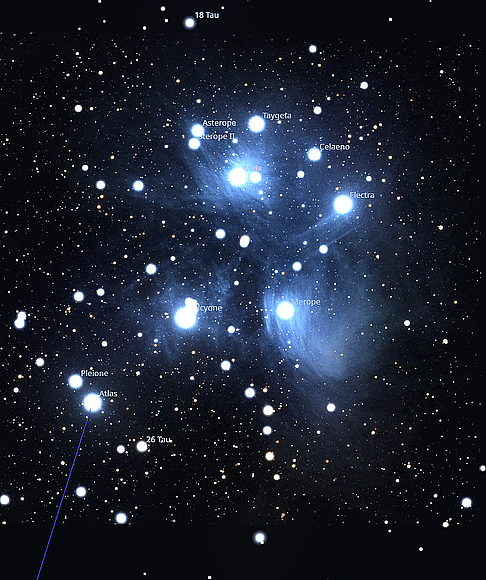
The Pleiades star cluster.
By mid-evening towards the end of the month, Gemini - the Twins, the heads of whom are conveniently marked by the first magnitude stars Castor and Pollux, clamber over the NE horizon. The constellation has been gate crashed by prominent Jupiter – brightest of planets in the night sky. As November turns to December, mid-evenings find the most majestic of all constellations, Orion, striding away from the SE horizon. Over the coming winter months, Orion and his stellar retinue will be the focus of our celestial rambles, until then do try to experience what the autumn sky has to offer, it will not disappoint.
November Sky Charts
Additional Image Credits:
- Planets and Comets where not otherwise mentioned: NASA
- Sky Charts: Stellarium Software and Starry Night Pro Plus 8
- Log in to post comments

